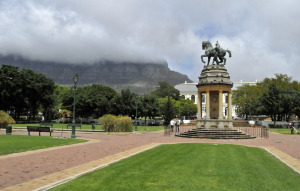The intellectual center of Cape Town is the Company’s Garden, originally used by the Dutch East India Company in the 1650s to grow food for resupplying ships on their way back from India after rounding the Cape of Good Hope. Today, the area is filled with historic statues, immaculately maintained gardens and plenty of over-fed squirrels. Nearby are the Houses of the South African Parliament, the National Library, a planetarium and world-class museums. The Slave Lodge Museum, in a building that once housed slaves adjacent the Company’s Garden, recounts a dark side of the garden’s history. Some of the Dutch ships picking up supplies dropped off Hindu slaves sold by their Muslim captors to Christian slave traders.
The Iziko South African Museum is located at the south end of the Company’s Garden. Founded in 1825, it has become one of the world’s finest museums of natural history, housing more than 1.5 million items, including a 70-feet long skeleton of a blue whale hung from the ceiling. The collection of fossils and skeletons illustrating biological evolution is particularly extensive and insightful. The sign accompanying a very rare skeleton of a lobed-finned fish closely related to the likely progenitor of all four-legged animals acknowledges that “it is difficult to believe that our very distant ancestors were fish similar to the coelacanths.” The sign next to the skeleton of Homo sapiens at the end of the evolutionary trail seems especially apt: “The only primate that presents a biological threat to the Earth, and to itself.”
Cape Town, with a metropolitan population of almost four million, led the “New York Times” 2014 list of top places to visit. If Cape Town is not on your list of cities to visit, it should be.
